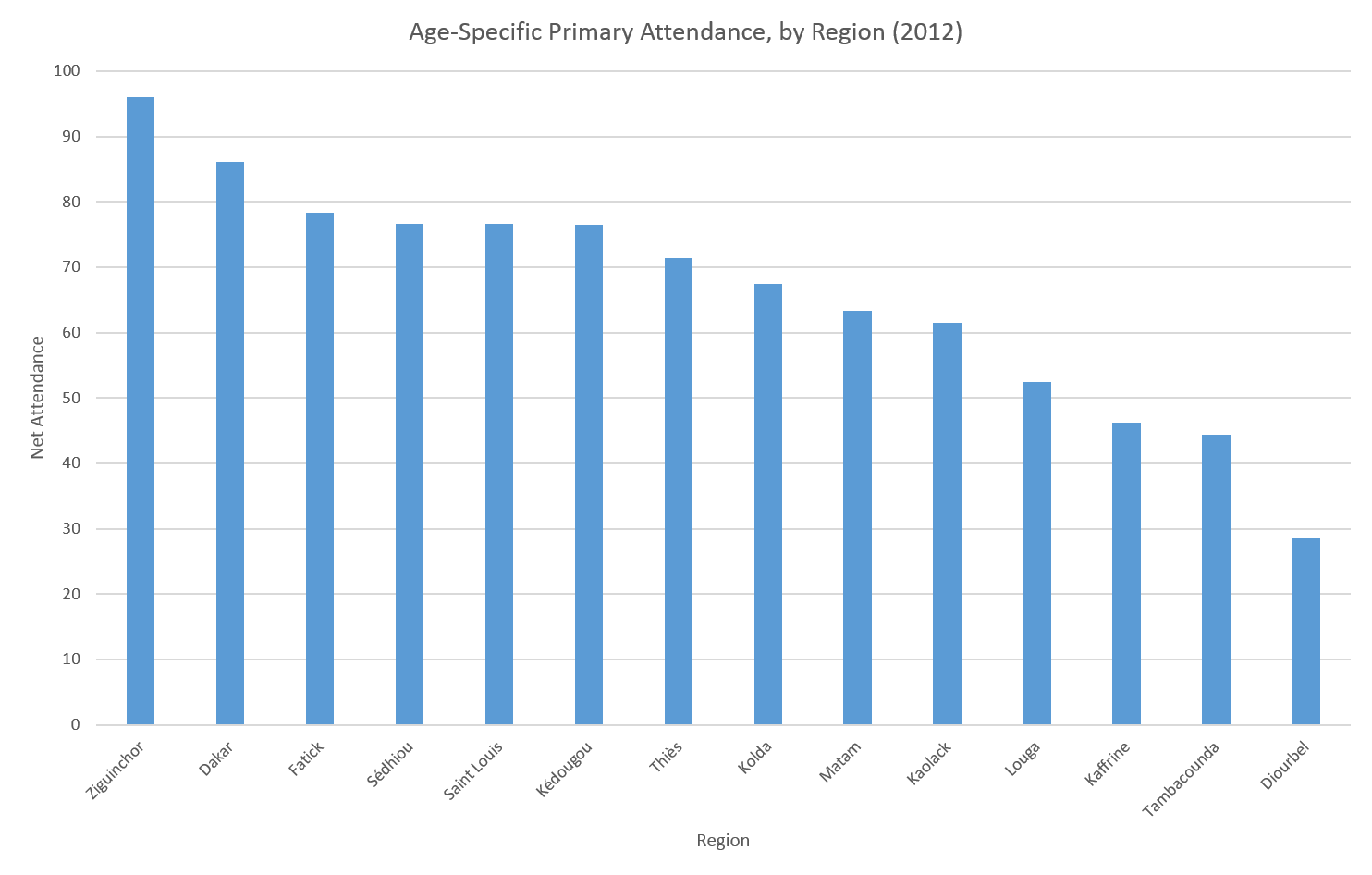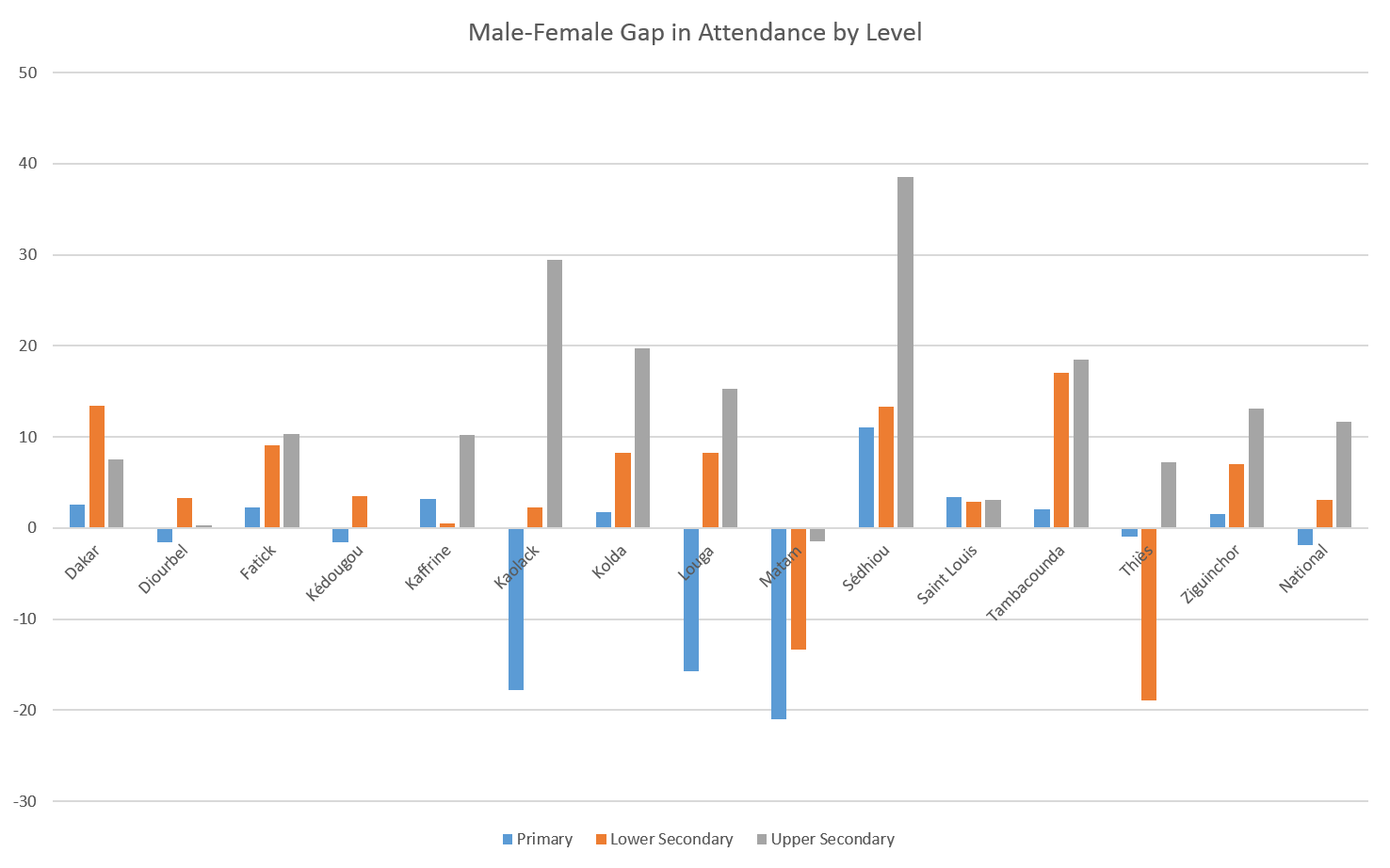You are here
Senegal’s Progress Still Marked by Regional and Gender Inequality
Although access to education in Senegal has been increasing rapidly over the past two decades, overall levels of educational attainment are still quite low. Currently, in less than half of all working age Senegalese ever attended formal education and in rural areas, the percentage is lower, with roughly 75% of working-age adults in Senegal never having attended school.
Nonetheless, access to school has increased substantially over the past two decades. The primary gross enrollment ratio reached 83.8% in 2012 and the percent of young people age 15-19 who had ever attended school increased from 53% to 65% over the last ten years. Moreover, young people were twice as likely as their peers had been five years earlier to have attended middle school (World Bank 2013).
As Figure 1 below shows, the gross enrollment ratio of students in primary school rose from roughly 60% to roughly 85% between 1996 and 2012. For the years in which we have data, it is also clear that access to lower secondary is rising substantially. The World Bank reports that in response to the lengthening of compulsory education, the transition rate from primary to middle school increased from 48% in 2005 to 90.5% in 2011. Unfortunately, this data is not yet available from UNESCO.
Figure 1 Gross Enrollment Ratio, by Level and Year 
One of the major issues Senegal faces in meeting its EFA commitments is inequality – students from different regions have starkly different opportunities to attend and complete schooling.
Out of School Children
Despite improving access, there are still many out-of-school children in Senegal. Nationwide, the percent of children out of school is 38%, which places Senegal in the middle of all West African nations, where out of school percentages range from a high of 64% in Niger to a low of 16% in Ghana.
Out-of-school rates in Senegal range quite a bit across sub-national regions. As Figure 2 shows, the sub-national primary attendance rate ranges from a high of nearly 95% in Ziguinchor to a low of less than 30% in Diourbel. More than 70% of students of primary age in Diourbel are not attending primary school.
Figure 2 Age-Specific Primary Attendance, by Region (2012)

Additionally, according to EPDC extractions from DHS survey data, rural students are much more likely to be out of school – 49% of rural students are out of school in rural areas, compared to only 21% of students in urban areas.
Out-of-school rates are more than twice as high among students from the poorest wealth quintile, at 53%, compared to less than 22% for those in the highest wealth quintile. Nonetheless, with more than 20% of students from the top wealth quintile out of school, this finding suggests that there are likely other reasons for Senegalese young people to drop out of school than simply financial considerations.
A Parallel System
One reason for the difficulties Senegal faces in meeting its commitments to meet universal primary access and completion, is that it has what can be considered a parallel education system of Koranic boarding schools, known as Daraas, operating alongside its formal education system. Starting at age 7, enrollment in Daraas is mutually exclusive with enrolling in the formal education system, which means that students who enroll in Koranic schools for cultural and religious reasons will miss out on the opportunity to gain foundational literacy and numeracy of the formal education system. Over the past decade, Senegal has attempted to integrate students from Daraas into elementary schools and has also developed a curriculum to teach literacy and numeracy in Daaras, in part with support from USAID and FHI 360’s Education de Base program.
Structure and Reform
Senegal has undertaken a number of reforms to its education system over the past two decades. In 2000, Senegal launched a 10-year education and training plan of action, known as the PDEF (Plan de Developpement de l’Education et de la Formation). The focus of this plan was to improve access, quality, and governance of the Senegalese education system. The PDEF established a framework to guide the expansion of the education sector.
At the end of the PDEF, in 2011, Senegal transitioned to a compulsory ten-year basic education system in 2011. More recently, in 2013, Senegal adopted a new 10-year sector-wide approach to education, known as the Program for Quality, Equity, and Transparency Improvements in Education (PAQUET, 2013-2025). The goal of PAQUET is to focus on assuring quality and equity while undertaking Senegal’s shift to an extended compulsory cycle.
Unfortunately, until now, the extension of compulsory education was not accompanied by the needed investments in expanding schools and infrastructure. As a result, the World Bank reports that 40% of middle schools in Senegal are still housed in outdoor shelters that are not protected from the elements (World Bank 2013). Schooling in shelters often limits students’ opportunity to learn, as students and teachers must wait for the end of the rainy season to begin classes. For example, in some regions in the south, students do not begin studying until December, despite the fact that the official start of school-year is in October.
Educational Finance
As is the case in many sub-Saharan African countries the poverty rate in Senegal is quite high. Per capita income in Senegal is $1,090, and 46.7% of Senegalese live in poverty (World Bank 2013). Currently, the government spends roughly 34.4% of its budget and 24.6% of total domestic resources to education. This equals about 6.2% of its GDP, which is higher than the average in sub-Saharan Africa of 4.5%.
Quality
Senegal has made attempts to improve teaching and learning by reducing its student - teacher ratio to 35:1 in lower secondary, which is one of the lowest in sub-Saharan Africa.
Nonetheless, quality is still low. Students in Senegal participate in the (PASEC), which assesses basic performance in Grade 5 in mathematics and reading. The test found that only 62% of students in Grade 5 were considered to have the needed mathematical understanding to continue on to lower secondary schooling without difficulty, while 17% were considered to not have met the minimum needed to continue and it was anticipated that 21% would face difficultly in lower secondary.
Gender Gap
The gender gap in Senegal varies significantly across regions – as Figure 3 below shows, in some regions of Senegal females are actually more likely to be enrolled in primary school than males – including in Kaolack, Louga and Matam. However, by the upper secondary level, in almost every region, males outnumber females, often by a substantial margin. One reason for this is likely early marriage and young pregnancy among females that prevents them from continuing on in school. Nonetheless, it is also important to recognize the regional differences in the gender gap – there are a few regions, such as Matam, where females outnumber boys at all levels of schooling. This means that approaches to gender-equality in schooling should be region-specific.
Figure 3 Male-Female Gap in Attendance by Level

EPDC Resources on Senegal
If you are interested in reading more about Senegal, EDPC resources on Senegal education include our country landing page, National Education Profile and a profile of Out-of-School Children. Among other options, our data allows for examining educational attainment and attendance, by gender, level and subnational region. Additionally, the database includes data on Senegal’s PASEC scores from 1996 and 2007.
References
World Bank. 2013. Senegal - Quality Improvement and Equity of Basic Education Project. Washington, DC: The World Bank.

Add new comment